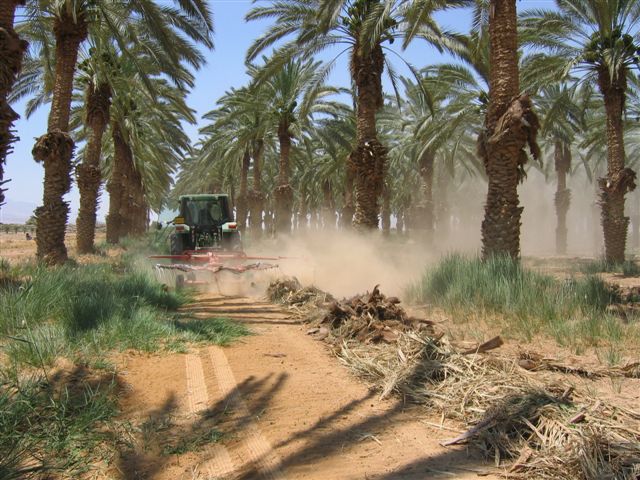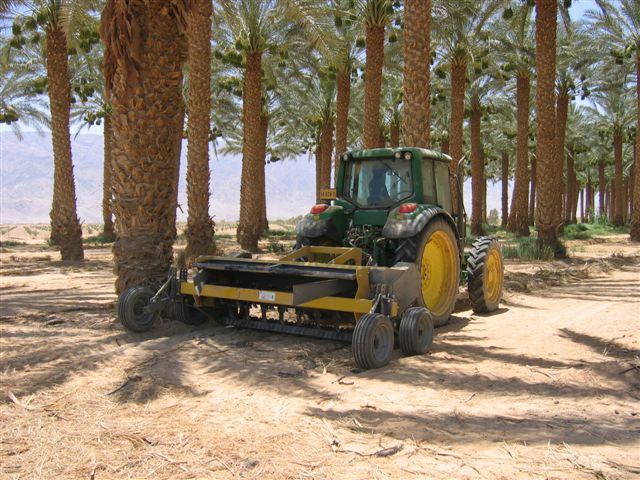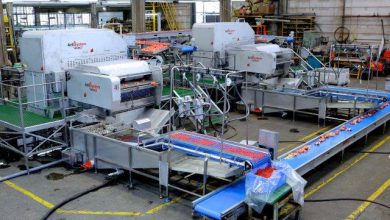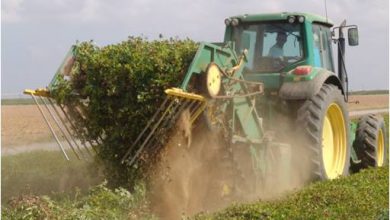New Method and Machinery for Collecting Pruned Palm Tree Branches
The new method includes several stages and requires no labor work
I. Sagi, et al.

The new method includes the following stages: 1. collection of the pruned branches into a windrow using a rotary rakes windrower, 2. chopping them with a new machine, 3. collection of the pieces into square bale using a large square baler. The method requires no manual labor and is extremely economical for palm tree growers
The Institute of Agricultural Engineering, together with the R&D departments of Southern Arava and Kibbutz Yotvata, has developed a novel method for the collection of pruned palm tree branches. The new method includes the following stages: 1. collection of the pruned branches into a windrow using a rotary rakes windrower, 2. chopping them with a new machine developed especially for palm tree branches, in conjunction with the Tzach Afula Metal Industry, 3. collection of the pieces into square bale using a large square baler. The method requires no manual labor and is extremely economical for palm tree growers.
Introduction
Date production is one of the most profitable and stable field of agriculture in Israel. There are currently about 35,000 dunams of plantation around the country, and in recent years, the field has recorded a 10% annual growth rate. One of the more complex problems faced by date growers is the amount of manual work invested in the care and treatment of the plantation. More than 10 work days per dunam are invested each year in the harvesting of the fruit and care of the plantation such as pruning of palm branches (branches extending up to 5 meters in length). The pruned branches fall and spread over the plantation (illustration 1). In production areas located in the north of Israel, characterized by heavy soil and high levels of precipitation, growers tend to crush the pruned branches and mixed it with soil. In time, they decompose and contribute to the overall soil composition. However, in the dry, desert areas of the Arava, the Dead Sea and the Jordan Valley (comprising about 65% of the entire production volume in Israel), precipitation is extremely limited and the pruned branches do not decompose. They hinders routine work procedures, can cause fires and obstruct movement of tractors and other harvesting equipment. Therefore, in these areas of the country, the pruned branches must be physically removed from the plantation each year. At Kibbutz Yotvata, manual harvesting operation costs exceeded 600 IS per dunam, which include labor, transportation for removing the branches and stationary large crushing machine. In addition, the manual collection of pruned branches is dangerous and hard physical work. Faced with the ever-increasing complexity of the problem, the high costs and the physical demands of the job, many growers prefer to leave the pruned branches on the ground, despite the numerous hazards. The goal of this research project was to develop a method and the machineries required for the mechanized collection of pruned palm branches.

Stage.1 – Collection of the pruned branches into a windrow using a rotary rakes windrower
The Windrower
The first stage in dealing with pruned palm branches is collecting them in windrows. Trials conducted indicated that a rotary rakes windrower was most suitable than other types of windrowers (illustration 2). In order to collect the branches closed to trees without damaging the rakes of windrower a special passive protection system was developed and mounted on the windrower. The unit enables safely collection of pruned palm branches lying adjacent to the trees. This rotating rakes collect the pruned brunches into windrow between etch two tree rows.

Stage 2 – Chopping them with a new machine developed especially for palm tree branches, in conjunction with the Tzach Afula Metal Industry
The Chopper
In the second stage the pruned palm branches were chopped into small pieces. A special chopper was designed for chopping palm branches as other types of available three point’s linkage crushers and small choppers proved to be inappropriate, since palm branches are long and comprised of a fibrous material that is difficult to crush. Therefore, the novel chopper, developed in conjunction with the Tzach Afula Metal industry (illustration 3) has an especially large entryway of 2.5 meters wide. The machine rides on 4 adjustable wheels and operated by a tractor puling it by three point’s linkage. The chopper has a 200 horsepower capacity with a chopping drum of 65 cm in diameter, equipped with 100 straight chopping blades. The machine rides over the branches windrows and the blades are adjusted to ground level in order to ensure complete chopping of the branches. The chopping process should be repeated whenever the pruned branches are intended for use as dairy farm ground covering.

Stage 3 – Collection of the pieces into square bale using a large square baler
The Baler
In the last stage the chopped materials are collected into large square bales using a large square baler. Trials were conducted on both small round baler and large square baler and the square baler was found to be more suitable (illustration 4). A bale of about 500 kg can be produced from each dunam of date palm trees.
In Summary
The method and the machineries are now in their second year of commercial operation at Kibbutz Yotvata, with great success. They have chopped and collected pruned palm branches from about 500 dumans of plantation without manual labor. The chopped material was used as dairy farm ground covering of the kibbutz. At the end, the ground covering gradually is mixed with the cow manure and will be recycled and used as compost. The cost of the new method, which involves no labor work, for collection of pruned palm tree branches is about 290 IS per dunam while, the cost of the previous method was about 600 IS per dunam.
Authors:
Itzik Sagi (isagi@volcani.agri.gov.il ) , Yossi Kashti (ykshti@volcani.agri.gov.il ) – The Institute of Agricultural Engineering
Ran Ziv, Ori Mishli – Kibbutz Yotvata
Amnon Greenberg – R&D Southern Arava
(Published in ISRAEL AGRICULTURE, 2010)




